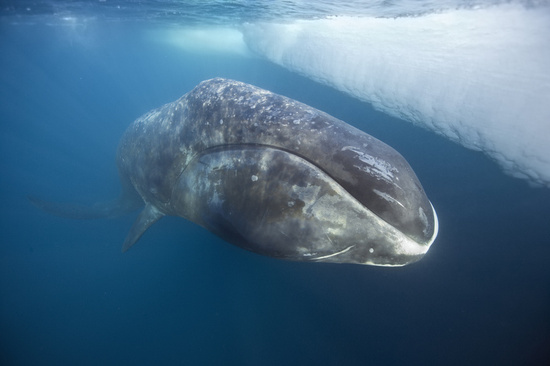bowhead whale


Bowhead whale distribution.
The bowhead whale (Balaena mysticetus) is a cetacean of the suborder Mysticeti, which means it has baleen plates instead of teeth for filtering food out of the ocean. Bowhead whales have extremely long baleen plates (up to 14 feet) and feed almost exclusively on zooplankton, which includes small to moderately sized crustaceans such as copepods, euphausiids, and mysids, as well as other invertebrates and fish. Bowhead whales have a dark body and a distinctive white chin. Unlike most cetaceans, they lack a dorsal fin.
The bowhead whale has a massive bow-shaped skull that is over 16.5 feet (5 meters) long and about 30–40% of their total body length. This large skull allows the bowhead whale to break through thick ice with its head. The bowhead whale also has a 17–19 inches (43-50 centimeters) thick blubber layer, thicker than any other whale's blubber.
Bowhead whales become sexually mature at about the age of 20 years, when they reach a length of about 35–40 feet (13–14 meters). Females generally have one calf every 3 to 4 years after a gestation period around 13 to 14 months. Calves are usually about 13 feet (4 meters) long at birth and weigh about 2,000 pounds (900 kilograms). Adults grow to about 45–60 feet long (14–18 meters) and weigh 150,000–200,000 pounds (75–100 tons). The average and maximum lifespan are unknown; however, some evidence suggests that they can live over 100 years.
Taxonomy
Kingdom: Animalia
Phylum: Chordata
Class: Mammalia
Order: Cetacea
Family: Balaenidae
Genus: Balaena
Species: mysticetus
Habitat
Bowheads live in the Arctic Ocean and adjacent seas. They spend most of the summer in relatively ice-free waters of seas adjacent to the Arctic Ocean. They are associated with sea ice the rest of the year.
Distribution
Bowhead whales are circumpolar, ranging throughout high latitudes in the Northern Hemisphere. They spend the winter associated with the southern limit of the pack ice and move north as the sea ice breaks up and recedes during spring. Five stocks of bowhead whales have been recognized. Three of these stocks occur in the North Atlantic: the Spitsbergen, Baffin Bay-Davis Straight, and Hudson Bay-Fox Basin stocks; and two in the North Pacific: the Sea of Okhotsk and Bering-Chukchi-Beaufort stocks.
There are thought to be more than 17,000 in existence. The bowhead is a target for indigenous hunters in Alaska, Chukotka and Greenland who are allowed to catch no more than 69 individuals a year under IWC rules.


